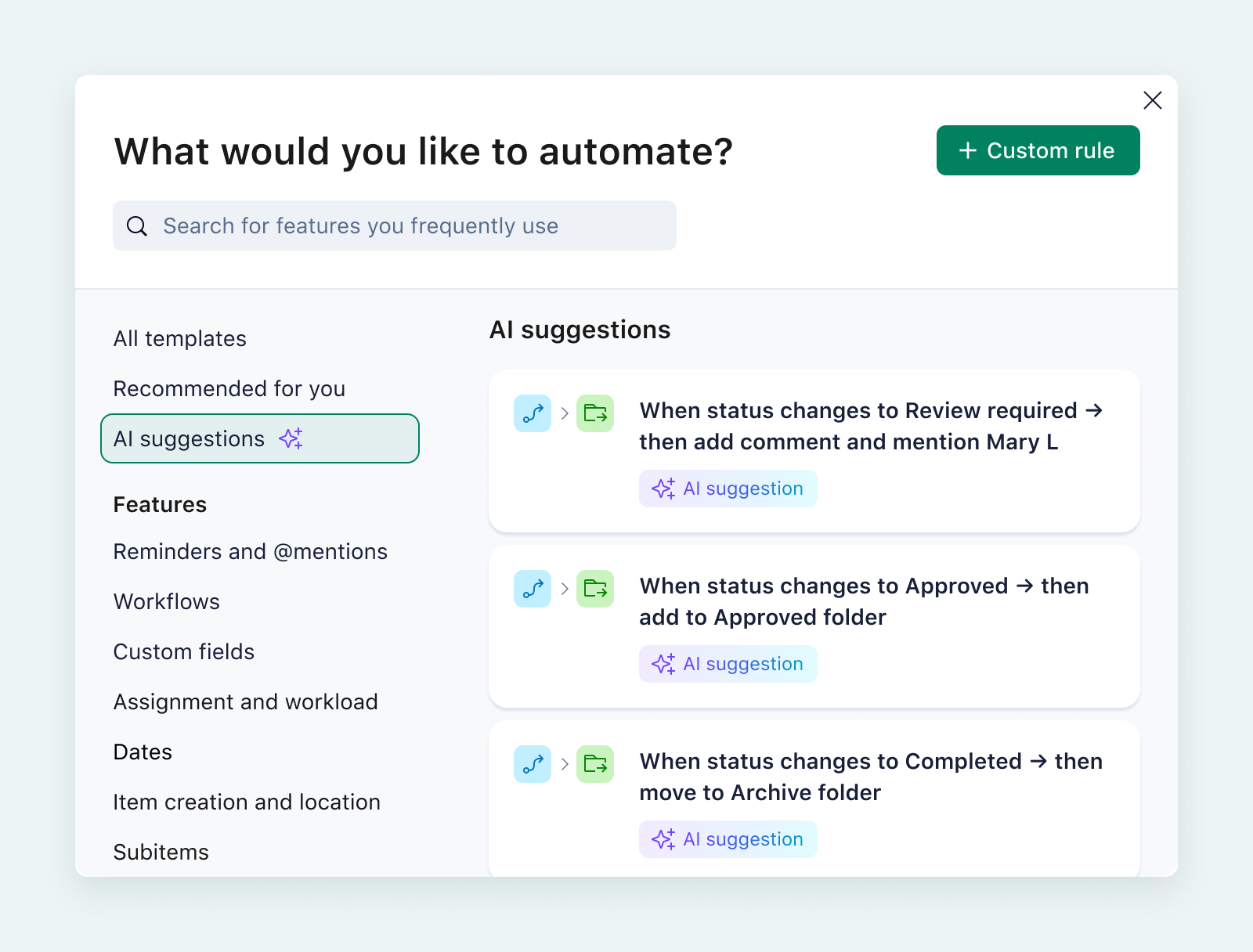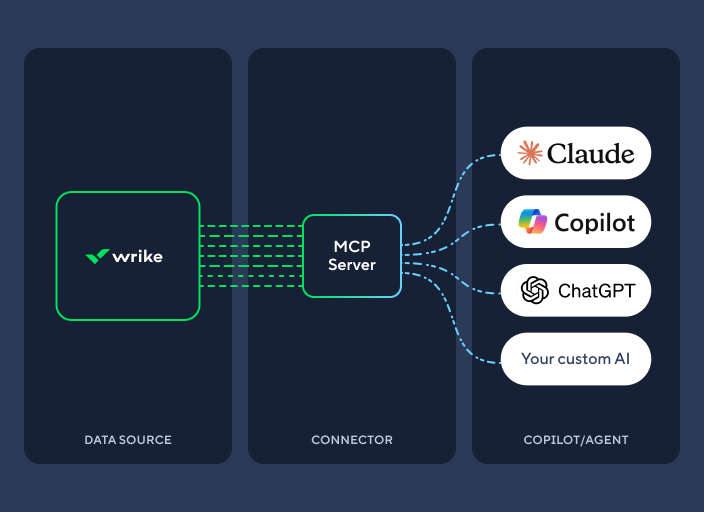Key takeaways:
- Tool sprawl is a major productivity drag: 59% of marketers have both planning and execution tools, but only half say they’re well-connected, leading to lost information and wasted time.
- AI adoption is rising, but integration is key: 64% of employees use AI agents at work, yet concerns about data accuracy and context remain high.
- Agentic AI’s accuracy depends on data: Combining public and proprietary data enables more reliable AI-driven actions based on real context.
- True integration bridges the gap between creativity and productivity: Wrike’s AI and MCP Server connect creative ideas to execution, automating workflows and centralizing data for seamless marketing operations.
- Closing this gap unlocks value: Centralized, AI-powered platforms like Wrike empower marketers to turn creative ideas into impactful outcomes, future-proofing teams for the next era of marketing.
As marketers, we value creativity. As leaders, we need productivity. Achieving that balance isn’t easy, especially in today’s fast-paced marketing environment that calls for bold, intuitive campaigns — delivered quickly and at scale.
As Wrike’s Chief Marketing Officer, I’m interested in how marketers are bridging this creativity-productivity gap. That’s one of the reasons why we commissioned an in-depth survey of more than 1,000 full-time knowledge workers in large U.S.-based enterprises.
The findings, reported on in a recent post by Wrike Chief Product Officer Alexey Korotich — “The secret to smarter agentic AI? Deeper context” — surfaced some surprising findings, but one overall message is clear: The key isn’t more tools, it’s better connection. And that starts with purpose-built AI features that can empower marketing teams to accelerate their workflows, from ideation through execution and analysis.
Too many tools, not enough connection
Our research shows that 59% of workers have access to both planning and execution tools, but only half say those tools are well-connected. This might look like toggling between tools, hopping in and out of digital workspaces, moving between communication channels, or using weak AI features that require heavy human input.
This tool sprawl means that we’re paying for lots of tech that actually makes our work harder. In fact, it’s creating a serious productivity drag, and the numbers back this up: 41% of employees have lost critical information in the past year due to information scattered across platforms, while 37% say important documents or messages are buried in threads and folders.
Our 2024 Impactful Work report revealed that marketers are wasting almost 13 hours a week fixing problems like this.
This makes the creativity-productivity gap much more than a technical issue — it’s a strategic roadblock.
|
What is tool sprawl? Tool sprawl refers to the unchecked proliferation of individual software applications. This leads to disconnected workflows, increased context-switching, and fragmented work. It’s a particular problem for marketers, who often adopt specialized tools for campaign management, analytics, content creation, and collaboration. The problems they encounter as a result include inefficient work, duplicated efforts, and lost productivity, all making the flow from ideation to execution so much harder. Marketers can resolve the problem of tool sprawl through better integration, smarter connections, and AI-powered processes. |
The promise — and potential pitfalls — of AI solutions
The research is clear: Disconnected tools and siloed data mean that teams spend too much time executing non-impactful work, leaving us with fewer resources for high-level orchestration. This problem is particularly acute in marketing departments and agencies, where strategy and creativity — human work — are our bread and butter, the areas we need to focus most on.
The solution that we hear most often? AI.
There’s no doubt that AI is transforming the way we work, generating top-quality content, facilitating fully automated workflows, and delivering rapid answers to natural language questions. In fact, agentic AI is increasingly the go-to support for most busy marketers.
In our survey, 64% of employees say they use AI agents provided by their employer, and more than half use them daily. This signals a clear appetite for intelligent assistance in our day-to-day work. When we asked our respondents how agentic AI can help them, their answers revealed much about the pain points that perpetuate the creativity-productivity gap. What’s evident is that we need AI to help us outsource much of the execution of our tasks, so that we can get on with orchestrating our goals.
Q: Which of the following workflow bottlenecks would you most want an AI agent to automate tomorrow?
| No. 1 | Entering data manually or moving information between tools | 41% |
| No. 2 | Proactively identifying and correcting process inefficiencies or redundant steps | 30% |
| No. 3 | Prioritizing tasks based on deadlines or impact | 29% |
| No. 4 | Monitoring workloads and balancing resources across teams | 28% |
| No. 5 | Tracking project progress and updating statuses | 27% |
| No. 6 | Searching for information across files, emails, or messages | 22% |
Our research also highlighted concerns about the veracity of AI-generated answers: More than a third of employees are worried that AI agents will act on inaccurate or incomplete information, while more than a quarter fear a lack of contextual understanding.
A recent report by McKinsey & Co. supports this sentiment, pointing out that almost all companies invest in AI, but just 1 % believe they are at maturity. These findings speak volumes about the confidence the public has in the emerging technology.
|
How accurate is agentic AI? The accuracy of agentic AI depends on the quality and context of the data it accesses. While public data provides a broad foundation, the best results come from integrated proprietary data — the type that an organization accumulates over time. Agentic AI is most effective when it combines both sources, helping it to make context-based decisions and deliver intelligent actions. Without access to well-structured, up-to-date, and accurate proprietary data, agentic AI’s performance and reliability may be limited. |

The game changer: True integration
The solution? Better integration between existing software and new AI-powered tools.
This was echoed in our survey, where respondents frequently cited a problem with disconnection, particularly for those who use brainstorming/planning tools in conjunction with task execution tools, like marketers. Only 53% say that these two types of tools are “very connected,” which means that somewhere along the line, ideas and plans are not automatically flowing into execution and reporting.
This type of workflow fragmentation is only compounded by data siloes — a problem caused, in part, by tool sprawl. In fact, a study by Experian found that 40% of business-critical data is trapped in data silos, leaving valuable information gathering dust.
Integrating and connecting that isolated data and its valuable context to agentic AI is a key priority for forward-thinking organizations, which is why we’ve recently launched the Wrike MCP Server. A Model Context Protocol server offers a secure, intelligent bridge between agentic AI systems and your organization’s proprietary information, like projects and tasks.
This allows AI agents like Microsoft Copilot, Anthropic’s Claude, and Perplexity to securely connect with Wrike’s data in real time, helping them generate and act on accurate insights based on your unique way of working.
It’s just one way that we are working to truly connect our marketers’ tools — and supercharge them with AI. Wrike MCP Server, Datahub, and our whole suite of award-winning Work Intelligence® tools help to deliver real, tangible support to marketers who can:
- Generate entire project plans for one customizable brief
- Automate repetitive tasks, proofing, and approvals with AI-powered workflows
- Use GenAI to write polished and professional content in multiple languages
- Summarize lengthy discussions, comment threads, and meetings
- Convert digital whiteboard ideas into end-to-end action plans
- Ask agentic AI and Wrike MCP Server to call up detailed campaign results in seconds
Through these features and more, our platform can connect every stage of the marketing process, from creative brainstorming and asset management to campaign execution and performance analysis.
See how our powerful MCP Server works below:
Closing the gap: From ideas to outcomes
Steve Jobs could have been talking about marketing when he said, “To me, ideas are worth nothing unless executed. They are just a multiplier. Execution is worth millions.”
Even top-class creative work is worthless if it’s never seen by the world. The real value comes from productivity, the process of turning creative ideas into successful execution.
Wrike can help close the creativity-productivity gap by:
- Centralizing, organizing, and connecting all proprietary and public/external data
- Facilitating real-time, in-context communication that moves work forward
- Integrating seamlessly with hundreds of third-party marketing apps
- Creating automated workflows that rapidly accelerate productivity
- Harnessing the power of AI to free marketers to contribute more valuable work
We believe that the future of marketing isn’t about adding more tools — it’s about connecting the ones we have. This is where Wrike is particularly powerful, consolidating marketing processes in one AI-driven platform. That means that every idea, asset, and insight is connected, accessible, and actionable.
If you want to future-proof your marketing workflows, stay ahead of the competition, and fully maximize the AI advances coming our way, it’s time to try Wrike for your marketing workflows. Reach out to our sales team to start a conversation today.
Methodology for “The secret to smarter agentic AI? Deeper context” report
Wrike surveyed 1,000 full-time knowledge workers in May 2025. Those employees were, at the time of the survey, all located in the U.S., 18 years or older, and employed at an organization with at least 1,000 employees globally. The workers were defined as employees working either fully in the office, fully at home, in a co-working space, or in a hybrid work setting.
FAQs on agentic AI and MCP Servers
FAQ 1: What challenges do marketers face when adopting AI, and how can they overcome them?
Marketers often face challenges such as fragmented data, disconnected tools, and concerns about AI accuracy. Overcoming these obstacles requires consolidating information, ensuring seamless integration between platforms, and leveraging all-in-one AI solutions like Wrike that provide context-aware automation and reliable insights for better campaign outcomes.
FAQ 2: How does agentic AI improve marketing productivity?
Agentic AI automates repetitive tasks, manages workflows, and provides intelligent insights by leveraging both public and proprietary data. When integrated with robust workflow management platforms like Wrike, agentic AI enables teams to centralize information, accelerate project delivery, and focus more on creative, high-value work.
FAQ 3: Why is data integration important for AI accuracy in marketing?
AI’s accuracy depends on access to high-quality, well-structured data. Integrating proprietary organizational data with public sources gives agentic AI the context it needs to make reliable, context-aware decisions. Solutions like Wrike MCP Server ensure that marketing teams’ data is connected and accessible, maximizing the effectiveness of powerful AI agents like Microsoft Copilot, Claude, and Perplexity.



